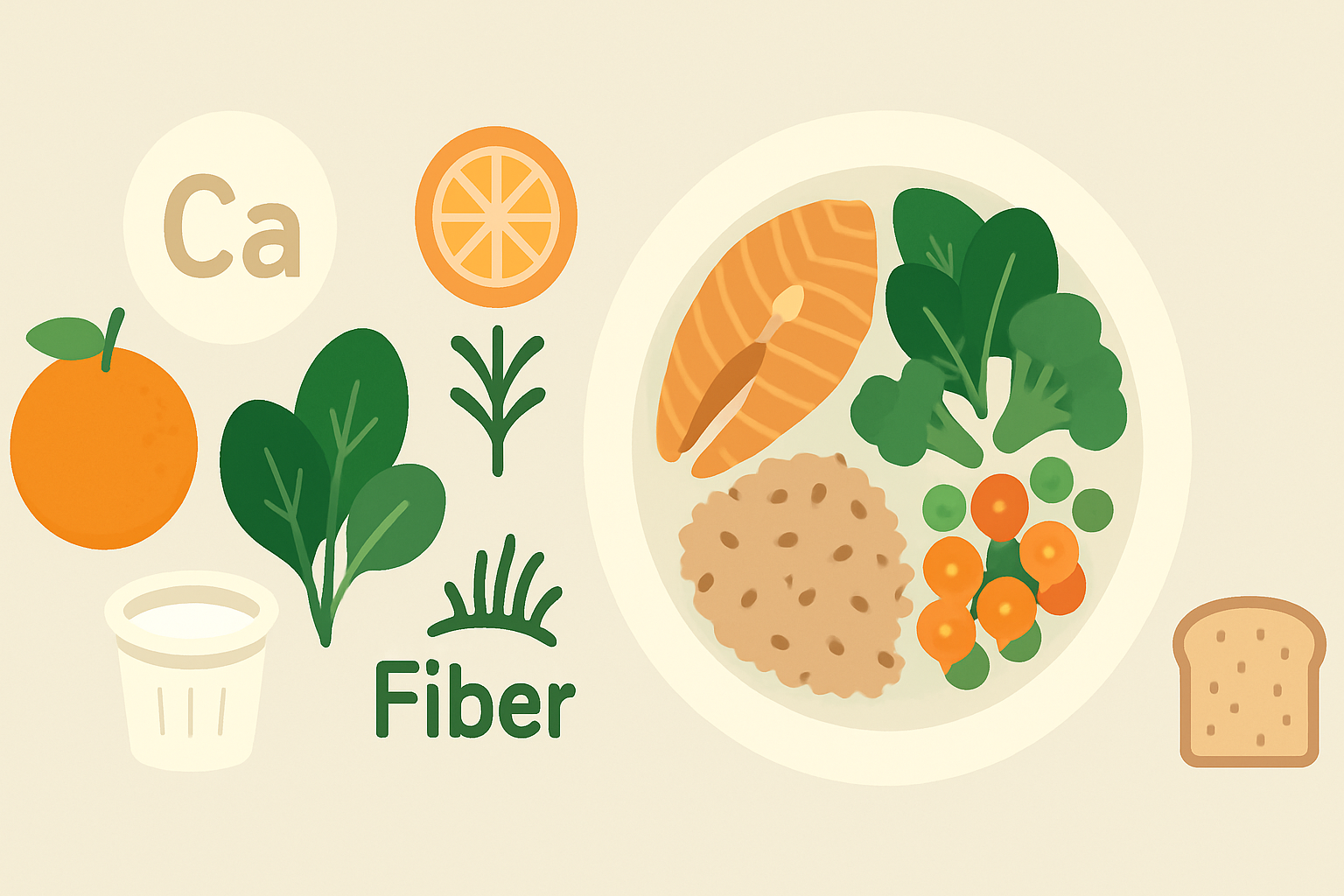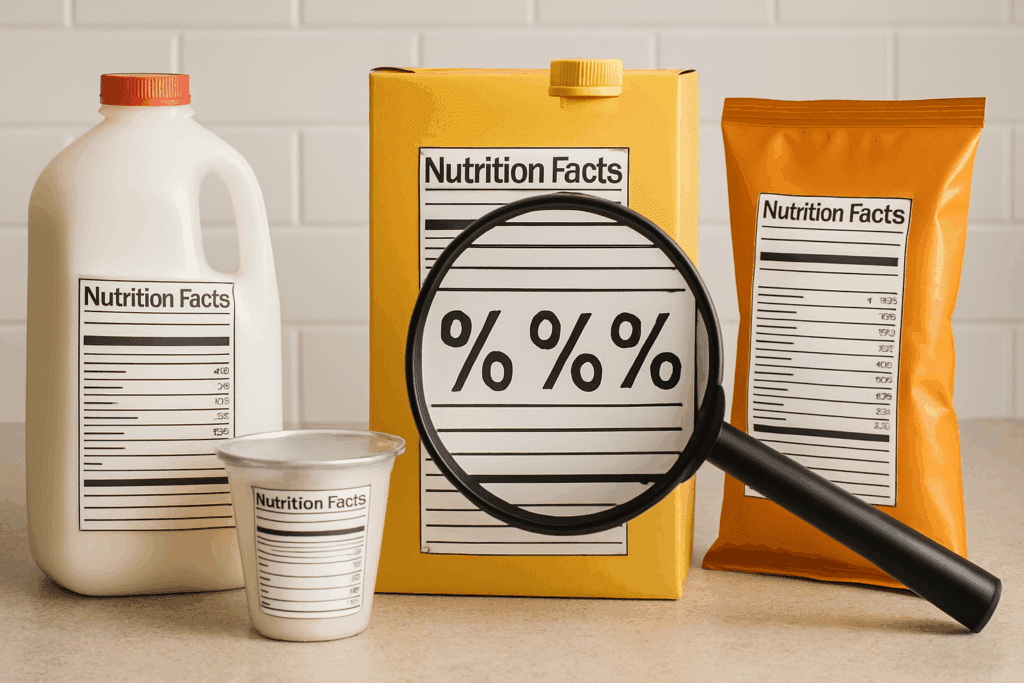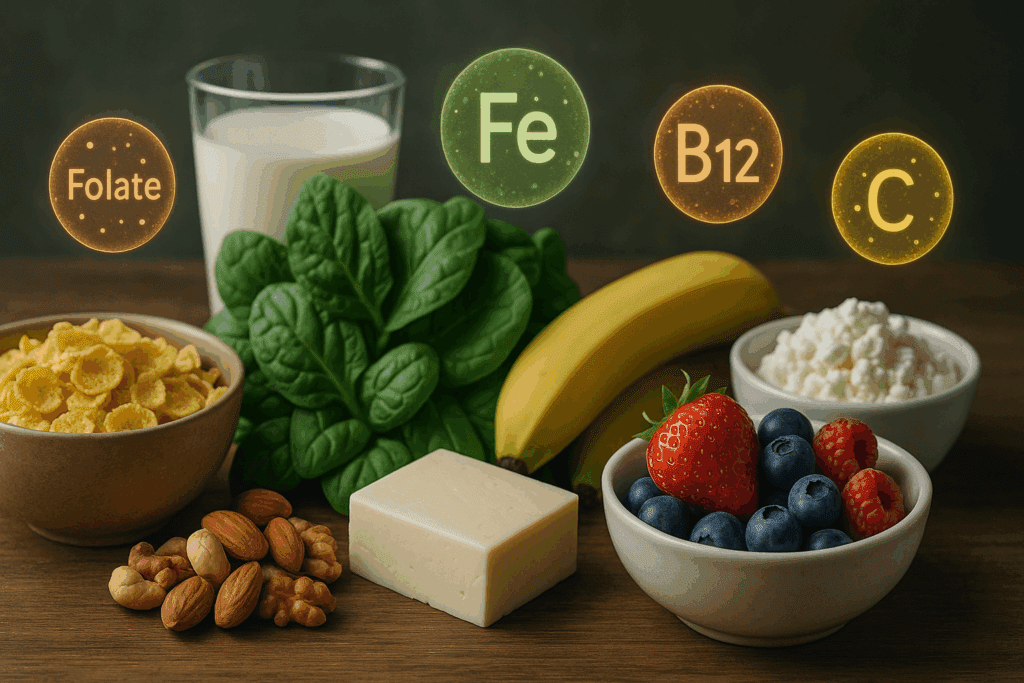Understanding the intricate language of food labels is essential for anyone aiming to make informed dietary choices. One of the most common terms you’ll encounter on packaging is “DV,” short for Daily Value. But what does DV in food mean, and why is it so crucial to your nutritional well-being? This article provides a clear, evidence-based explanation of Daily Values (DVs), decoding their function on nutrition labels and demonstrating how they can guide your daily food decisions. Through a deeper grasp of this system, you’ll be empowered to take charge of your health, meet nutritional goals, and better understand what you consume every day.
You may also like: 4 Ways to Have a Healthy Diet: Expert Tips Backed by Science for Better Nutrition and Long-Term Wellness
Defining Daily Values: The Building Blocks of Nutritional Awareness
At its core, the term DV, or Daily Value, refers to a set of nutrient reference values used by the U.S. Food and Drug Administration (FDA) to help consumers contextualize the nutrient content of a food product within the scope of a total daily diet. But for those seeking a short definition for Daily Values, it can be understood as the percentage of a nutrient provided by a single serving of a food item, based on a standard 2,000-calorie daily diet.
Daily Values are not merely numerical suggestions but evidence-based benchmarks rooted in scientific understanding of human nutritional requirements. They serve as an anchor for nutritional labeling, offering consumers a practical method for assessing whether a food is high or low in essential nutrients such as vitamin C, calcium, dietary fiber, or saturated fat. Understanding this percent of Daily Value definition in simple terms can dramatically enhance one’s ability to compare products and make choices aligned with specific health needs, whether that involves reducing sodium intake or increasing fiber consumption.

Is Percent Daily Value Found in Food Labels?
The answer is unequivocally yes. When reading the Nutrition Facts panel on food packaging, you will consistently find the percent Daily Value (%DV) listed alongside many key nutrients. This percentage indicates how much a nutrient in one serving of the food contributes to the recommended total daily intake. For instance, if a serving of yogurt contains 20% DV of calcium, it means that the product provides one-fifth of your daily calcium requirement, assuming a 2,000-calorie diet.
Yet many consumers are unaware that these percentages are carefully calculated and regulated to ensure accuracy. In fact, the inclusion of %DV is not optional but mandated by the FDA for most packaged foods. For each nutrient listed, manufacturers must display the percentage based on updated Daily Value recommendations, which are periodically reviewed and adjusted as nutritional science evolves. Thus, when asking “is percent Daily Value found in food labels,” it is important to recognize this as a foundational element of nutritional transparency, legally required to support consumer health literacy.
Determining the Percentage of Vitamin Value in Everyday Foods
One of the most practical uses of Daily Values is to determine the percentage of vitamin value found in foods we consume regularly. Understanding how to interpret this data enables individuals to strategically balance their nutrient intake throughout the day. For example, if breakfast cereal offers 90% DV of vitamin B12 and a multivitamin provides 100%, one can gauge their total intake and assess whether supplementation is necessary or excessive.
This practice is especially vital for populations with specific dietary needs, such as pregnant individuals requiring more folate, or vegetarians and vegans needing sufficient vitamin B12. By checking food labels and comparing the %DV of essential vitamins and minerals, it becomes easier to ensure nutritional adequacy without overreliance on supplements. To determine the percentage of vitamin value in a product, consumers can simply locate the nutrient on the label and read the corresponding %DV. With regular practice, this step becomes second nature, supporting both short-term health decisions and long-term wellness planning.

Food for Life: Define Daily Values as a Lifelong Nutritional Tool
When it comes to living a balanced, health-conscious life, it is vital to see Daily Values not merely as numbers on a label but as a part of a lifelong nutritional strategy. To define Daily Values in the context of a food-for-life philosophy is to embrace them as flexible, guiding tools that adapt with your needs as you age, change dietary patterns, or face medical conditions.
A young athlete may use Daily Values to ensure sufficient protein, iron, and carbohydrate intake to fuel performance, while an older adult may rely on them to moderate sodium, cholesterol, and added sugars. What is the Daily Value of food if not a metric designed to evolve with the human body across different life stages and health priorities? Recognizing DVs as tools for prevention and optimization places them at the heart of a food-for-life mindset, empowering consumers to proactively support their health rather than react to deficiencies or conditions after they arise.
Why the Daily Value of Food Matters More Than You Think
Although nutrition science can often seem overwhelming, understanding what is the Daily Value of food remains one of the most accessible and actionable insights available to the average consumer. These values are calculated based on extensive scientific data and provide essential information about both the minimum and maximum amounts of various nutrients recommended for optimal health.
Critically, DVs are not just about reaching a baseline. They also offer red flags for overconsumption. For nutrients like saturated fat, sodium, and added sugars, the %DV can highlight when a food might contribute to health risks such as cardiovascular disease, high blood pressure, or diabetes. In contrast, for nutrients like fiber, calcium, and potassium, high %DV values are generally desirable. Thus, understanding the Daily Value of food enables individuals to not only meet their nutritional needs but also avoid overindulgence in harmful ingredients. In this way, Daily Values function both as targets and warnings—a dual role that underscores their importance in health maintenance and disease prevention.

Translating the Percent of Daily Value Definition into Action
A critical part of embracing the percent of Daily Value definition in simple, applicable terms is knowing how to translate that knowledge into everyday dietary choices. For example, if a frozen meal contains 40% DV of saturated fat and 50% DV of sodium, you might consider choosing a different option or balancing it with low-sodium, low-fat foods for the rest of the day. This interpretive ability is essential in a world where hyper-processed foods often skew our perceptions of what is nutritionally sound.
Reading nutrition labels with a DV-focused mindset allows consumers to quickly assess whether a food is nutrient-dense or calorie-heavy without beneficial components. It also reinforces mindfulness in consumption, encouraging choices that reflect both immediate health benefits and long-term goals. Ultimately, understanding and applying Daily Values fosters a form of nutritional literacy that transcends dieting trends and marketing tactics, putting real control back in the hands of the eater.
Empowering Consumers: How to Determine the Percentage of Vitamin Value with Confidence
To determine the percentage of vitamin value in foods with confidence, one must go beyond passive reading and engage actively with the information provided. Start by identifying nutrients of concern or interest, such as vitamin D or iron, and then note their %DV on various products. Recognizing patterns across similar food categories can help develop a sense of which items are most nutritious within a given budget or dietary restriction.
It’s also important to understand the context of %DV ranges. A food that offers 5% or less of a nutrient is typically considered a low source, while one that offers 20% or more is seen as a high source. Knowing this helps assess whether a single item contributes meaningfully to your overall intake. Through this lens, consumers can gradually tailor their grocery shopping habits, ensuring they get more value—nutritional and financial—from their purchases. By learning how to determine the percentage of vitamin value with precision and context, the average person becomes far more adept at sustaining a balanced and nourishing diet.

Is Percent Daily Value Found in Food Labeling for Every Nutrient?
While the FDA requires that many nutrients be included with their respective %DV on food labels, not all nutrients are represented this way. For some nutrients—like trans fat, protein (in certain cases), and sugar alcohols—%DV may be omitted. This does not necessarily mean these components lack importance, but rather that scientific consensus may be evolving, or daily requirements may vary widely among individuals.
Nonetheless, the vast majority of critical vitamins and minerals—such as vitamin A, vitamin C, calcium, and iron—do have established Daily Values. Understanding which nutrients are consistently labeled helps consumers focus their attention appropriately. It also reinforces the importance of reading beyond the marketing claims on the front of the package and engaging with the full Nutrition Facts panel to make informed decisions. So, when asking if percent Daily Value is found in food labels, the most accurate answer is that it is present for many essential nutrients, although not universally applied to every single ingredient or additive.
Short Definition for Daily Values and Their Role in Disease Prevention
Returning once more to the short definition for Daily Values, we can say they are nutrient reference points that indicate the recommended intake levels for various essential nutrients. But this seemingly simple concept has profound implications for public health. Numerous studies have shown that improved nutritional awareness, often sparked by understanding and applying %DV, correlates with better dietary habits and lower rates of chronic disease.
When consumers learn to interpret DVs as part of a proactive health strategy, they become more capable of selecting foods that align with medical guidelines for managing hypertension, preventing osteoporosis, supporting immune function, and regulating blood sugar. The widespread adoption of nutrition labeling has thus become a cornerstone of disease prevention, reducing healthcare costs and enhancing quality of life at a population level. In this way, even a short definition for Daily Values can carry deep significance when translated into personal and societal action.
Food for Life: Define Daily Values as a Habit, Not a Hurdle
To truly embrace a food-for-life approach, one must internalize the principles of nutritional balance without becoming overwhelmed by numbers. Define Daily Values as a habitual part of shopping, cooking, and eating. Let them inform, not intimidate. By treating DVs as friendly guides rather than rigid rules, people can cultivate sustainable eating patterns that prioritize health while allowing room for enjoyment and cultural expression.
This shift in perspective is particularly important for younger generations and communities where nutrition education may be lacking. Public health initiatives that teach children to interpret DVs early in life can foster lasting habits that extend into adulthood. Moreover, framing DVs as tools for empowerment rather than restriction helps combat diet culture and encourages more positive relationships with food. A daily value of food is not about perfection—it’s about consistent, informed choices that reflect personal needs and preferences.

Frequently Asked Questions: Daily Values and Nutrition Labels
What are some common misconceptions about Daily Values and how can we clarify them?
A frequent misconception is that Daily Values are exact requirements for everyone, rather than general benchmarks. While many assume these figures represent the exact amount of nutrients each person should consume, the reality is that they are based on a 2,000-calorie diet, which doesn’t reflect the needs of all individuals. For instance, active adults, children, and older adults may have significantly different nutritional requirements. This is why it’s essential to contextualize the percent of Daily Value definition—simple comparisons work only when your individual needs are factored in. Understanding this flexibility not only improves label literacy but aligns better with a food-for-life define daily values approach.
How does understanding Daily Values influence long-term eating habits?
Grasping what does DV in food mean allows individuals to build dietary awareness over time, influencing food choices in a sustainable way. When used consistently, these percentages encourage moderation and balance rather than restrictive dieting. This long-term perspective, often absent from short-term nutrition advice, aligns well with the food for life define daily values philosophy. For instance, recognizing that excessive sodium or added sugar can silently build up through multiple snacks enables smarter meal planning throughout the week. Over time, this approach fosters intuitive eating grounded in nutritional awareness.
Can Daily Values help with customizing diets for specific health conditions?
Yes, using the percent Daily Value system can be a practical tool in tailoring dietary patterns for chronic conditions such as hypertension, diabetes, or osteoporosis. For example, if someone is managing high blood pressure, they might focus on products with lower %DV of sodium and higher potassium. By consistently reviewing the labels, you can determine the percentage of vitamin value or mineral content and select products accordingly. Understanding what is the daily value of food becomes crucial in fine-tuning micronutrient intake to address specific medical goals. This method provides a personalized, non-invasive strategy to complement clinical treatment plans.
Why aren’t Daily Values available for all nutrients?
Not all nutrients have established Daily Values due to limitations in available scientific data or variability in individual tolerance levels. For example, protein may lack a %DV on certain products unless a specific claim is made about its quality. Likewise, nutrients such as sugar alcohols, trans fats, or bioactive compounds like polyphenols are not currently assigned official DVs. This can make it harder to evaluate foods comprehensively, even for informed shoppers. Still, by learning to determine the percentage of vitamin value for listed nutrients, consumers can piece together a nutritionally complete picture.
How are Daily Values different from RDAs or DRIs?
The percent of Daily Value definition—simple and standardized—often gets confused with Recommended Dietary Allowances (RDAs) or Dietary Reference Intakes (DRIs). While RDAs and DRIs are tailored for age, sex, and life stage, DVs are broad reference numbers used mainly for labeling. This simplification makes nutrition labels easier to interpret at a glance, though they offer less precision than personalized dietary guidelines. However, the trade-off in specificity is balanced by improved accessibility and widespread application. Thus, what does DV in food mean differs from what an RDA or DRI means, both in scope and purpose.
How can consumers use Daily Values for meal planning?
Daily Values provide a powerful tool for constructing balanced meals. Rather than fixating on calories alone, understanding what is the daily value of food enables shoppers to build meals rich in nutrients like fiber, iron, and calcium while limiting saturated fats or added sugars. For instance, pairing foods with complementary nutrient profiles—such as legumes and leafy greens—can help ensure that no single nutrient falls short or becomes excessive. The short definition for Daily Values as reference points becomes a practical guideline for assembling grocery lists and meal plans rooted in whole foods.
What innovations are emerging in how Daily Values are displayed on packaging?
New front-of-package labeling initiatives and digital tools are beginning to change how Daily Values are communicated. For example, QR codes linking to nutrient profiles or color-coded indicators (like traffic light labels) aim to make the percent Daily Value definition simple and intuitive. These innovations are especially helpful for people with visual impairments or limited nutrition knowledge. Some companies are also experimenting with augmented reality apps that allow users to scan a product and get tailored feedback based on their dietary goals. As these technologies evolve, they could redefine how consumers interact with the concept of what does DV in food mean.
Can learning about Daily Values influence children’s eating behaviors?
Introducing the concept of Daily Values in age-appropriate ways can help children develop healthy eating habits from an early age. Schools that integrate nutrition label education into science or health curricula often report increased student interest in what is the daily value of food. Through interactive learning, kids begin to recognize the importance of nutrients like calcium and vitamin D for their development. Teaching them to determine the percentage of vitamin value in snack choices can empower healthier decisions without moralizing food. This educational approach supports a food for life define daily values mindset that can last into adulthood.
Are Daily Values the same in all countries?
While the concept of Daily Values exists globally, the actual numbers and terminology vary by country. In the United States, the FDA regulates Daily Values, but other nations use similar systems with slight differences, such as Nutrient Reference Values (NRVs) or Guideline Daily Amounts (GDAs). This can complicate matters for international consumers trying to apply the percent of Daily Value definition simple across borders. It’s also important for travelers or those importing foods to understand that %DV interpretations may shift depending on national guidelines. Still, the core goal—nutritional literacy—remains consistent across all frameworks.
How might Daily Values evolve with future nutrition science?
As our understanding of nutrition advances, it’s likely that the Daily Value system will undergo revisions to reflect emerging research. For example, new findings on gut health, micronutrient bioavailability, or genetic factors may prompt updates to current standards. Additionally, we may see the inclusion of new categories for nutrients like omega-3 fatty acids or prebiotics. As this happens, having a short definition for Daily Values that remains adaptable and consumer-friendly will be crucial. Continued updates will ensure that what does DV in food mean stays relevant, evidence-based, and responsive to the diverse needs of a modern population.

Conclusion: Decoding Daily Values for Smarter Nutrition and Lifelong Health
In a world where food marketing is louder than ever and diet trends come and go, understanding what does DV in food mean is more than just a nutritional curiosity—it is a vital skill. This science-backed guide has shown that Daily Values are more than static numbers on a label; they are dynamic tools that empower individuals to take control of their health. Whether you’re learning how to determine the percentage of vitamin value in your breakfast cereal or adopting a food-for-life philosophy, embracing DVs fosters better decisions, stronger health outcomes, and a deeper appreciation for what fuels your body.
From recognizing why percent Daily Value is found in food labels to interpreting the short definition for Daily Values in everyday contexts, this knowledge offers clarity in a cluttered food landscape. Each meal becomes an opportunity to align with your nutritional goals, avoid hidden dangers, and build habits that nourish both body and mind. So, the next time you hold a food package in your hands, let the Daily Values guide you—not just for today, but for life.
Further Reading:
The Lows and Highs of Percent Daily Value on the Nutrition Facts Label


